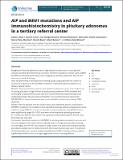Por favor, use este identificador para citar o enlazar a este item:
http://hdl.handle.net/10261/203531COMPARTIR / EXPORTAR:
 SHARE SHARE
 CORE
BASE CORE
BASE
|
|
| Visualizar otros formatos: MARC | Dublin Core | RDF | ORE | MODS | METS | DIDL | DATACITE | |

| Título: | AIP and MEN1 mutations and AIP immunohistochemistry in pituitary adenomas in a tertiary referral center |
Autor: | Daly, Adrian F.; Cano González, David A. CSIC ORCID; Venegas Moreno, Eva CSIC; Petrossians, Patrick; Dios Fuentes, Elena CSIC; Castermans, Emilie; Flores-Martínez, Alvaro; Bours, Vicent; Beckers, Albert; Soto-Moreno, Alfonso CSIC ORCID | Palabras clave: | AIP FIPA Acromegaly Somatostatin analog Resistance MEN1 Pituitary adenoma Pasireotide |
Fecha de publicación: | 2019 | Editor: | BioScientífica | Citación: | Endocrine Connections 8(4): 338-348 (2019) | Resumen: | [Background] Pituitary adenomas have a high disease burden due to tumor growth/invasion and disordered hormonal secretion. Germline mutations in genes such as MEN1 and AIP are associated with early onset of aggressive pituitary adenomas that can be resistant to medical therapy. [Aims] We performed a retrospective screening study using published risk criteria to assess the frequency of AIP and MEN1 mutations in pituitary adenoma patients in a tertiary referral center. [Methods] Pituitary adenoma patients with pediatric/adolescent onset, macroadenomas occurring ≤30 years of age, familial isolated pituitary adenoma (FIPA) kindreds and acromegaly or prolactinoma cases that were uncontrolled by medical therapy were studied genetically. We also assessed whether immunohistochemical staining for AIP (AIP-IHC) in somatotropinomas was associated with somatostatin analogs (SSA) response. [Results] Fifty-five patients met the study criteria and underwent genetic screening for AIP/MEN1 mutations. No mutations were identified and large deletions/duplications were ruled out using MLPA. In a cohort of sporadic somatotropinomas, low AIP-IHC tumors were significantly larger (P = 0.002) and were more frequently sparsely granulated (P = 0.046) than high AIP-IHC tumors. No significant relationship between AIP-IHC and SSA responses was seen. [Conclusions] Germline mutations in AIP/MEN1 in pituitary adenoma patients are rare and the use of general risk criteria did not identify cases in a large tertiary-referral setting. In acromegaly, low AIP-IHC was related to larger tumor size and more frequent sparsely granulated subtype but no relationship with SSA responsiveness was seen. The genetics of pituitary adenomas remains largely unexplained and AIP screening criteria could be significantly refined to focus on large, aggressive tumors in young patients. |
Versión del editor: | https://doi.org/10.1530/EC-19-0027 | URI: | http://hdl.handle.net/10261/203531 | DOI: | 10.1530/EC-19-0027 | E-ISSN: | 2049-3614 |
| Aparece en las colecciones: | (IBIS) Artículos |
Ficheros en este ítem:
| Fichero | Descripción | Tamaño | Formato | |
|---|---|---|---|---|
| endocrine_connections.pdf | 1,29 MB | Adobe PDF |  Visualizar/Abrir |
CORE Recommender
PubMed Central
Citations
9
checked on 30-mar-2024
SCOPUSTM
Citations
19
checked on 24-abr-2024
WEB OF SCIENCETM
Citations
18
checked on 29-feb-2024
Page view(s)
178
checked on 24-abr-2024
Download(s)
164
checked on 24-abr-2024

